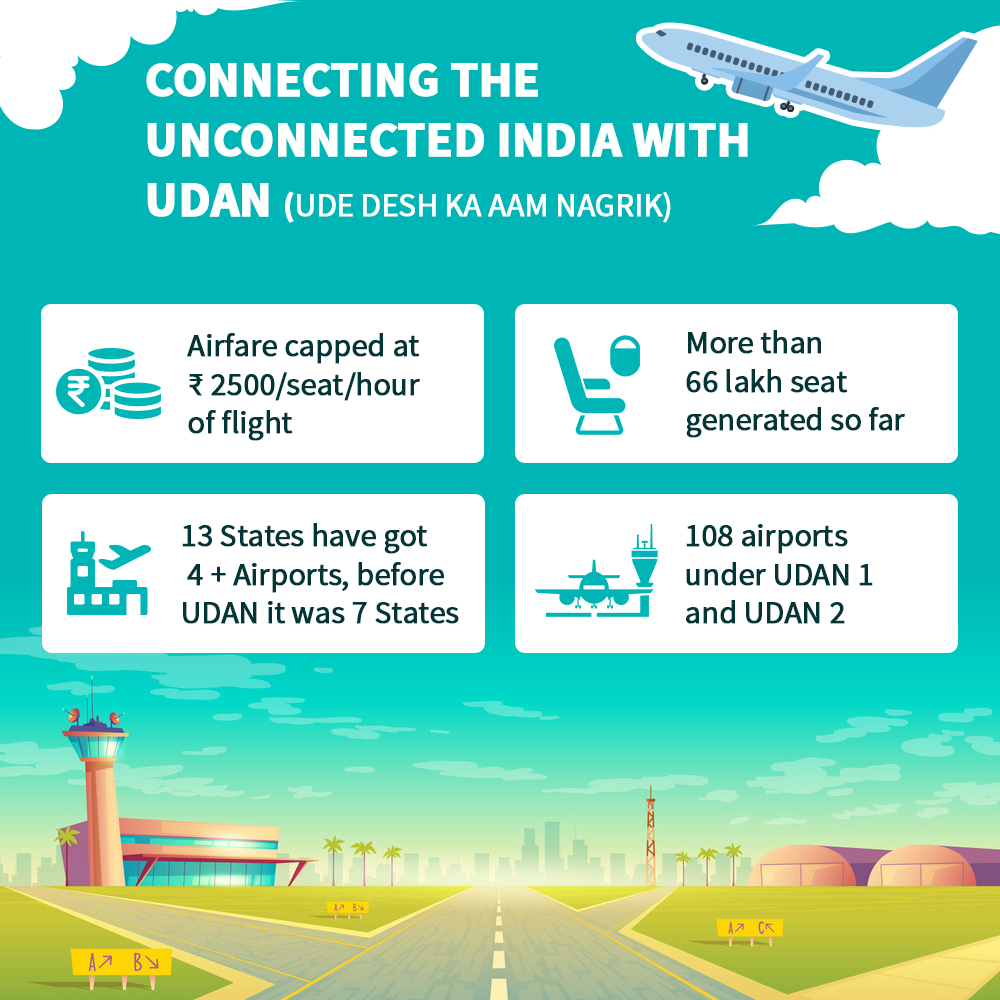Giving wings to every Indian – UDAN scheme

‘The lives of the middle class are being transformed and their aspirations are increasing. Earlier aviation was considered to be a domain of the select few. That has changed now ‘– PM Modi
Better connectivity drives regional economic growth and promotes opportunities across the regions. The Government led by PM Modi has placed great reliance on fulfilling the aspirations of the middle class through creation of assets and also making them affordable and accessible to them. Moreover building connections to tier -2 and tier-3 cities creates a network by bringing in more people into the aviation network.
As the UN celebrates the International Civil Aviation Day on December 7, primarily to raise awareness about the importance of civil aviation and the role it plays in influencing lives of common citizens, the Regional-Connectivity Scheme (RCS) named UDAN, has served an adrenaline shot for small town airports within a short span of time.
UDAN or (Ude Desh ka Aam Nagrik) is the government’s initiative to make air travel to India’s tier II and tier-III cities affordable to the common man. As the Prime Minister emphasised that the scheme would enable a person who wears a ‘hawai chappal’ to fly on the ‘hawai jahaj’ by reviving more than 400 unused and under-utilised airstrips in the country’s vast hinterlands. The idea behind the scheme is to jump-start the regional aviation market by improving profitability of under –developed regional routes. Under the scheme, the government offers incentives to airlines to flag off new flights to neglected smaller cities and towns by providing Viability gap funding to make these operations profitable. Airlines are required to bid for exclusive rights to fly on the regional routes opened under the scheme/
Why is it important?
Citizens from tier II and tier-III cities lacking air services have a latent demand for efficient and fast transportation to state capital, regional or national metros and global destinations. However aviation business has accrued high operating costs which includes aircraft capital charges, air port charges, crew maintenance among others .Unless there is sufficient air traffic, airlines are not being able to generate necessary revenue to cover operating cost and recover their capital .
The UDAN scheme gives India’s aviation sector a boost by giving chance to small and first-time operators to be part of the rapid growth in passenger traffic. Moreover UDAN has been developed through extensive and multiple consultations with stakeholders to make a win-win scheme for both passengers and airlines. Passengers get air connectivity and the ability to fly with fares capped at Rs 2500. The routes to be connected were chose by airlines themselves based on their assessment of the market potential between various sectors. It is a first of a kind scheme globally to stimulate regional connectivity through ensuring route profitability and market based mechanism to allocate subsidy. Moreover the scheme is also a component of the National Civil Aviation policy formulated in 2016.
While the scheme has provided a fillip to regional connectivity with 108 airports to be made made operational under UDAN-1 and UDAN-II along with 13 states getting more than 4 airports, it s operational metric rests on minimum government, pro-market-iterative approach with the process of bidding decided by the airlines depending on the assessment of the demand and not by the government. Further the aviation industry will generate data regarding which routes will work and which won’t where an iterative approach would allow for experimentation and create a stronger foundation for a viable regional aviation market. Here government will play the role of the facilitator in helping the industry meet public expectations.


Below given is the link that captures experiences of the people which showcases how UDAN scheme has made flying affordable and gave wings to people’s aspirations :
Thus, the UDAN is a flagship scheme of the government introduced to enable air operations on unserved routes, connect regional areas to promote balanced regional growth that will strengthen the overall aviation market at modest market-discovered price. Passengers will not only benefit from enhanced air services , better traffic that will generate more revenue but is a big step towards making flying affordable for masses in sync with PM Modi’s vision of ‘New India’.

















